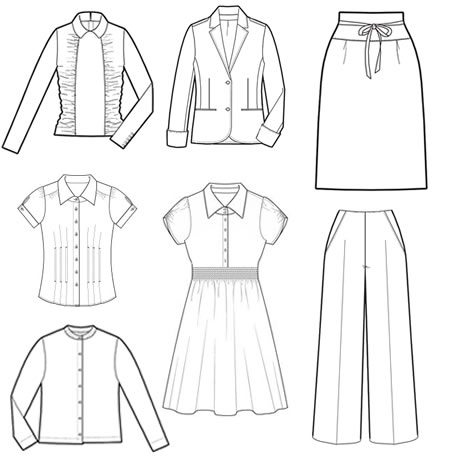Professional Dress Code Illustrations

February to May of each year is when my job as an enforcer of a professional dress code for high school students goes into action. Pictured are several illustrations that I prepared to be put into the instructions to help students such as those in past years who have failed to read the dress code and brought clothing that is inappropriate. The person with final authority over the dress code felt that my illustrations made the instructions too long, so they were not included, although most of my suggestions for improving the wording were included. Already during our very first week this spring, we have had all kinds of dress code violations, which makes me wish that the visual illustrations had at least been tried as a reinforcement for the written material. My springtime job interfaces with juniors and seniors in high school who come for a week at a time to serve in my state's senate to learn about the legislative process. As a chaperon for the students, who are called "pages," I am responsible for ensuring that they are appropriately dressed. Despite detailed written instructions mailed in advance and verbal warnings during orientation, female students frequently arrive in the mornings with skirts that are too short, fabric that is transparent and necklines that are too low. It is an ongoing battle.
The modesty standards I enforce for the students are set by people who represent our state senators. The dress code is called a "professional" one, and it is consistent with other dress codes enforced in professional work environments. The high school students who participate in our program are familiar with dress codes for school and camp, but few of them have worked in a place where a professional dress code was expected. As a result, they either neglect to read or choose to ignore the instructions and then are required to change clothing when they arrive for service dressed inappropriately. Asking the students to change is difficult enough, and when they express a poor attitude in the process, it makes my job of enforcing the dress code most unpleasant. My opinion is that the depiction of office work environments on TV and in movies is a major contributor to teens' misperception of a professional dress code. Rarely are women in office settings in the media depicted with modest attire, yet "modest" is a key descriptor that sets apart a professional dress code from a casual one. To give you an idea of how simple a professional dress code can be, here are excerpts from ours. You would be amazed at how frequently every one of these points is challenged by students who bring clothing that violates this code.
Jackets, Dresses and Skirts
Appropriate and conservative suits, skirts, or dresses are acceptable. The shortest allowed skirt and dress length is 2” above the knee. A slip is suggested for wearing underneath unlined skirts. It is recommended to bring at least one pair of loose-fitting pants and a modest top so that if other garments fail the dress code, at least one outfit will be available to permit entry for service.
Pants
Loose-fitting pants can be worn with blouses, sweaters, or suit jackets. Pant fabric must be loose enough and thick enough so that undergarment outlines stay hidden. Capri pants are allowed but must be below the knee and loose fitting. Leggings may be worn but do not count as pants. Tops worn with leggings must meet the same length requirement as skirts and dresses.
Tops
Blouses and tops must be professional and not low cut. No cleavage—cleavage must be covered from all angles, including from the top. Necklines must stay in place to cover cleavage all day long. No blouses or tops with see-through/sheer/transparent material (including unlined lace) are allowed, not even with a camisole underneath. No spaghetti straps or bra straps are permitted to be visible. No see-through material is allowed over the shoulders, including see-through lace. Tops must be loose enough and thick enough so that the outlines of undergarments stay hidden. Camisoles are allowed but must be worn underneath another top that stays on all day, for example, when worn to raise a neckline under a v-neck blouse. Camisoles with see-through lace at the top that reveals cleavage underneath are not permitted. Any type of clothing made of denim is not allowed.